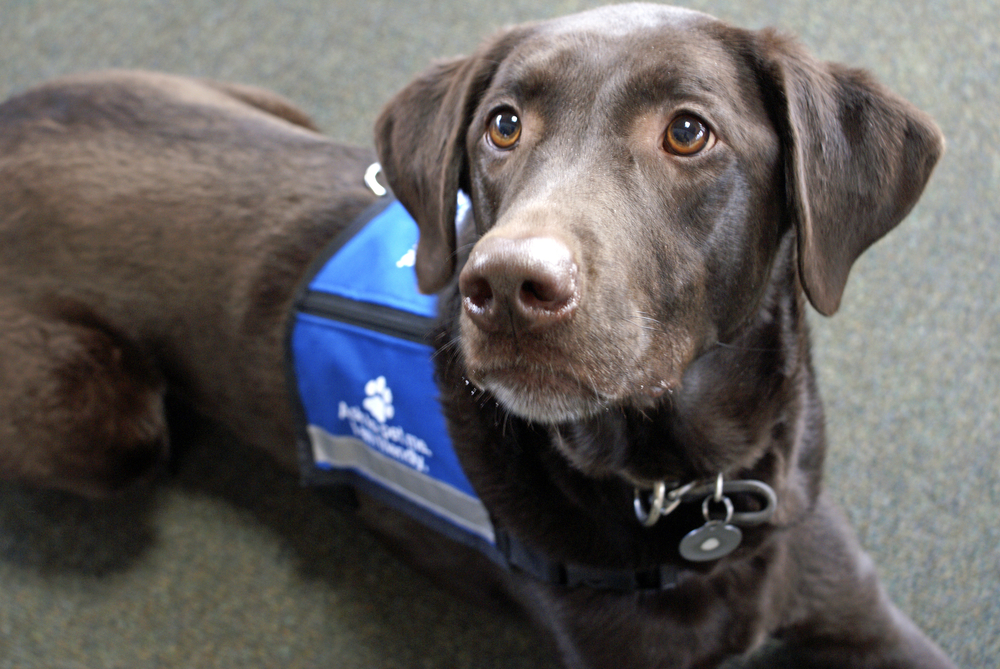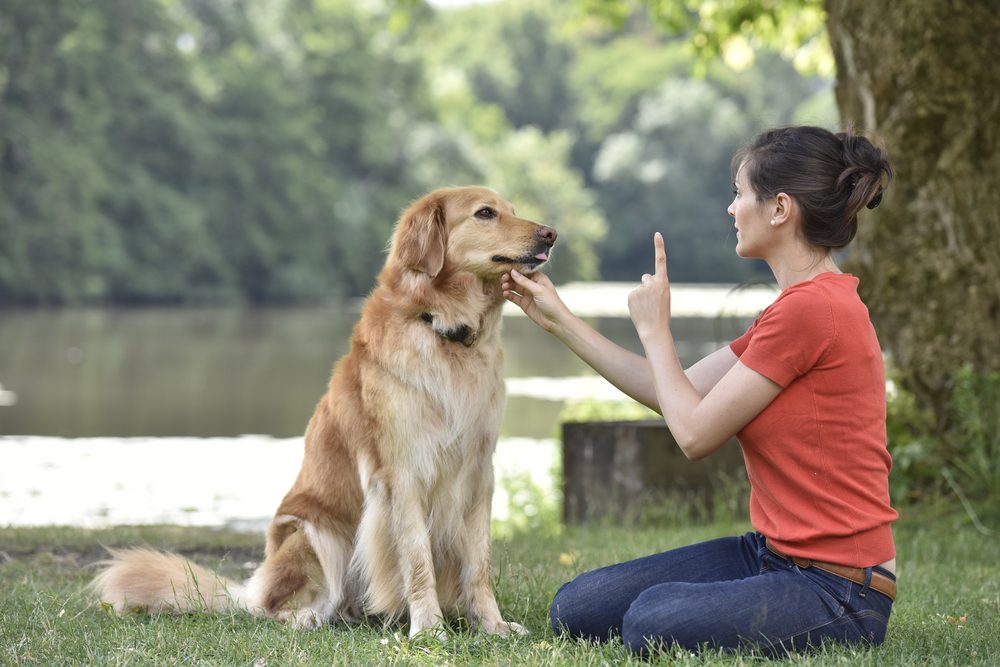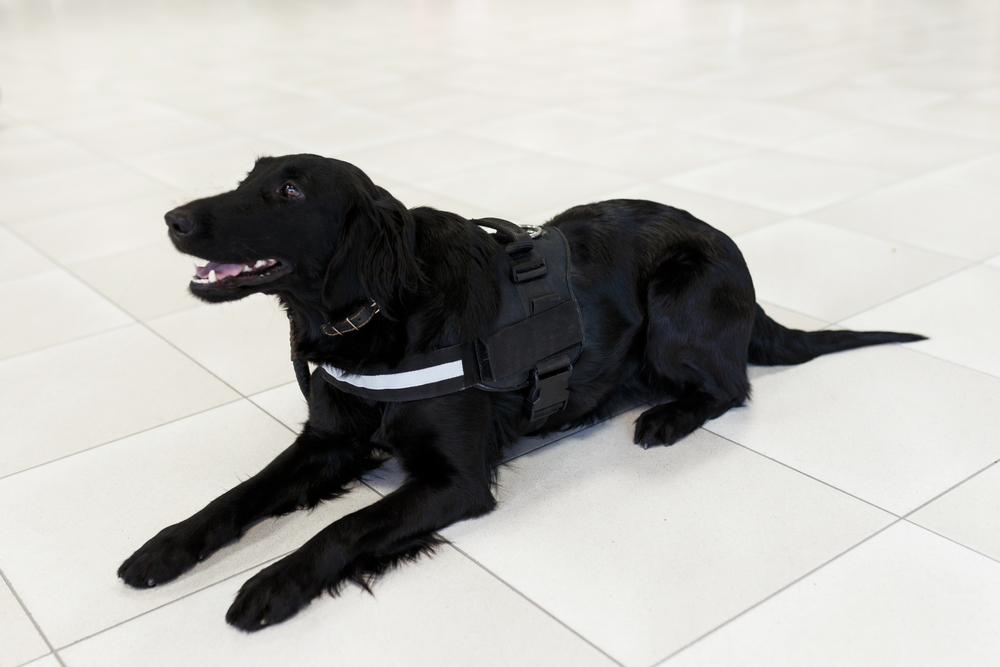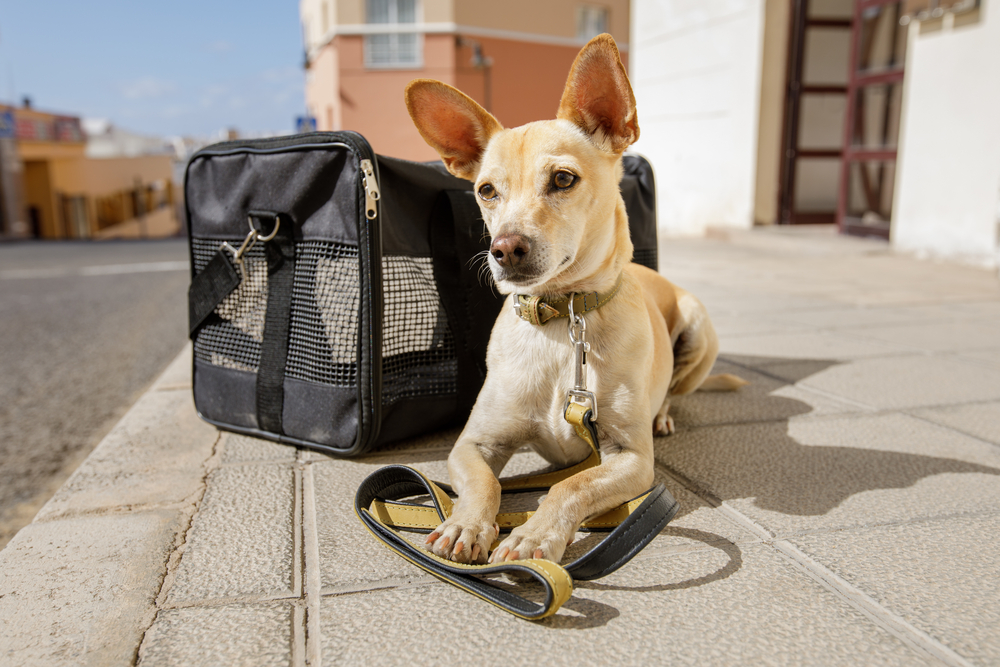
Dogs bring joy to people around the world every day. People of all ages can enjoy playing or simply spending time with a loved dog. There are numerous studies showing the benefits of a furry companion, and many researchers believe that the love that we share with dogs is the result of similarities in social behavior. After all, almost 40% of dog owners see their pet as a part of the family and don’t actively think of their dog as an entirely different species. All of this is to say that dogs can have tremendous impacts on human lives.
The companionship of a dog, from a therapeutic perspective, is in many ways preferable to the companionship of another human. People are complicated, emotionally demanding, and come and go. As dogs bond closely with their owner, they can provide 24/7 emotional support to a patient.
In essence, human-dog relationships are both less complicated and more stable than relationships between humans. As a result, many people who need stress-free companionship turn to their pets.
For an animal to be recognized as a therapy dog from a medical and legal perspective, it must receive certification and training. Getting certified can mean a therapy dog can be with its owner at all times, even in public areas where animals aren’t normally permitted. Training helps a service dog learn to behave in public as well as have the skills necessary to emotionally support its owner.
What Is the Process to Certify a Therapy Dog?
If you would like to own a therapy dog, the process is relatively simple. Although the process does take some time and effort, there are only three steps to register a therapy dog:
Step 1: Adopt
The first and most important step for owning a therapy dog is choosing which one to adopt. You will want to do your research, as certain breeds are better suited for therapy services than others (like golden retrievers and labradors, to name a few). You can also consult professional dog trainers and veterinary professionals to get advice on choosing the best dog for the job.
However, you should not just worry about the breed, because this is not a sure indication of a dog’s personality, behavior, or temperament. For example, you might find a golden retriever that is not very sociable and does not like to be touched (even though this is generally not the case), while you could find a breed that is not generally associated with therapy work, like a rottweiler or pit bull, that is perfectly suited to cheer up patients. At the end of the day, it will come down to the individual dog.
So, once you have done your homework on breeds and traits to look out for, you will need to visit a shelter in your area. We always recommend adopting dogs, rather than buying from a breeder. Shelter dogs are often some of the most loving, friendly animals you can find.
While dogs can become therapy animals at any age, it is much easier to train dogs if you adopt them as puppies. That said, older dogs can be just as loving and obedient as the younger ones.
When you have found a dog that you think meets the necessary criteria, be sure to spend time with him or her in order to play, relax, and observe their behavior and temperament. It’s pretty easy to tell if a dog is well-suited for therapy sessions. If they can cheer you up, they can probably cheer up a patient, too!
Step 2: Train



Once you have chosen a dog to take home, you will need to begin the training process as soon as possible. While there are various methods for training dogs, we recommend that you consult a professional. Many dog owners prefer to do the training themselves, but getting advice from people who train animals for a living can save you time and help ensure that your dog is ready to see patients.
In general, you will want to make sure that your dog exhibits certain positive behaviors and avoids negative ones. For example, when you go to register your dog, they will look for behaviors that are ill-suited for therapy work. Dogs that like to jump on people, bark excessively, or chew on things will not qualify. Additionally, dogs that are overly shy and do not like to approach people will not make the cut either.
Therefore, you will need to make sure that your dog exhibits the following traits:
- Friendly
- Obedient
- Quiet
- Unaggressive
- Outgoing
- Gentle
- Relaxed
- Not easily startled
Step 3: Register Your Dog



Most therapy dog certification organizations require dogs to be at least one year old, and fully updated on all vaccines and shots. You will need to provide documentation from your veterinarian regarding your dog’s age and medical history.
When you think your dog is ready to be a therapy animal, they must be registered by a qualified organization (like usserviceanimals.org) and pass a test. This requires a certification test. During this test, your dog will need to show the right qualities for therapy work. If they cannot, the testing organization will ask that you continue to train them until they can meet the requirements.
It is also important to note that your dog will not be the only one tested when you go to register. Your abilities as a dog handler will be put to the test as well. If you cannot show that your dog follows your commands and that you know how to properly manage your pet in a therapeutic setting, your dog will not be certified.
The American Kennel Club (AKC) recommends that dogs pass the Canine Good Citizen (CGC) test prior to registration. According to the AKC, this exam focuses on 10 key traits:
- Test 1: Accepting a Friendly Stranger. The dog will allow a friendly stranger to approach and speak to the handler (the dog owner) in a natural, everyday situation.
- Test 2: Sit Politely for Petting. The dog will allow a friendly stranger to pet it while it is out with the handler.
- Test 3: Appearance and Grooming. The dog will permit someone to check its ears and front feet, as a groomer or veterinarian would do.
- Test 4: Out for a Walk (walking on a loose lead). Following the evaluator’s instructions, the dog will walk on a loose lead (with the handler/owner).
- Test 5: Walking Through a Crowd. The dog will walk through a small crowd of pedestrians, passing in close proximity to at least three people.
- Test 6: Sit and Down on Command and Stay in Place. The dog must demonstrate the ability to sit AND lie down on command, then the owner chooses the position for leaving the dog in the stay.
- Test 7: Coming When Called. The dog will come when called by the handler (from 10 feet away on leash).
- Test 8: Reaction to Another Dog. The dog will behave politely around other dogs. Two handlers and their dogs approach each other from a distance of about 20 feet, stop, shake hands, and exchange pleasantries.
- Test 9: Reaction to Distractions. The evaluator will select and present two distractions such as dropping a chair, to which the dog must react properly.
- Test 10: Supervised Separation. This test demonstrates that your dog can be left with a trusted person. The evaluator will hold your dog’s leash while you go out of sight for three minutes.”
If your dog can pass the CGC test, there is a very good chance that they will be approved as a therapy dog. However, once your dog is registered and certified, it is still best to proceed with caution. Some animals may pass with flying colors, but may still be unprepared to deal with patients in a new environment. It is recommended that you test the waters with friends or family members before taking your dog to more formal therapy sessions at a healthcare facility.
Requirements for a Therapy Dog
Dogs must meet certain criteria to qualify as therapy animals. Therapy dogs are privately owned, but they must undergo a screening process to ensure that they are a good fit for patients. A registered therapy dog will need to meet the following criteria:
Temperament
Therapy dogs must be well-tempered. This means that they are not quick to anger, and do not get stressed out easily. They should enjoy being touched, and not react aggressively if a patient mishandles them. While some of these behaviors can be trained, dogs will need to be inherently calm to some degree.
Shedding
Therapy dogs should not shed excessively. Shedding can be a major problem for people with allergies, and it creates a mess for hospital or clinic staff to clean up. Therapy dogs exist to brighten people’s day, not cause more problems.
Social
Therapy dogs must be social and friendly. This is perhaps the most important requirement, as they will need to cheer people up when they need it the most. However, dogs that are overly energetic can be too rough with certain patients (especially the elderly), so therapy dogs must be social, but not overly-enthusiastic.
Adaptable
Therapy dogs will need to adapt to various environments. Sometimes they may need to provide support in highly stimulating environments, while sometimes they may need to help patients in cramped living spaces. A dog that is uncomfortable or unadaptable may become shy or even aggressive, which can cause unnecessary harm to patients.
Frequently Asked Questions
While there is no shortage of legal and medical information available, it can be hard to parse through the facts and get the information you need regarding ownership of a therapy or emotional support animal. Some of the most common questions are answered below:
How Do I Qualify to Have an Emotional Support Animal?
Talk with a medical professional to determine your eligibility for an emotional support animal. Most mental health professionals recognize the therapeutic value of support animals and will be happy to write you a recommendation or prescription.
How Do You Get a Therapy Dog?
Most people are more than happy to certify a pet they already own as a therapy animal. Others will purchase an animal from a reputable breeder or trainer and use that animal for emotional support. Others will adopt a pet and obtain a letter to recognize the pet as an ESA (emotional support animal). There is no ‘right’ or ‘wrong’ path to going about it.
How Much Does a Therapy Dog Cost?
The cost of a therapy dog can vary depending on your approach. Some dog shelters have free adoption days where you can adopt a pet for free. Breeders can charge several thousand dollars for a pet, and trained service animals can cost over $50,000 depending on what they’re trained for.
Fortunately, for those who already have a pet they’re looking to certify as a service animal, costs are minimal. Certifications cost well under $100, and many medical professionals won’t charge anything for a letter of recommendation. If you aren’t actively seeing a medical professional, a letter from a doctor will cost around $200.
When Do I Need a Doctor’s Letter?



While there are other, less common circumstances where you’ll need a doctors note for an emotional support animal, the primary reasons are:
- Travel: If you’re traveling with a therapy animal, you’ll need to provide paperwork proving your dog isn’t simply a pet. An official letter can make sure there won’t be any issues for your therapy dog on planes, in hotels, or at other touristic destinations.
- Official Business: Many public buildings, areas, and government offices don’t permit pets. An official doctor’s letter for your emotional support animal can minimize the likelihood you’ll experience any problems when bringing your therapy dog.
What Are the Benefits of a Therapy Animal Over a Pet?
While many individuals choose to certify their pet as an official therapy animal or emotional support animal, some individuals run into problems when attempting to use a pet as a therapy animal.
Although sometimes the only difference between a therapy animal can be a certificate or a doctors note, having your animal’s paperwork in order can mean:
- Your animal will be permitted on public transportation
- Your animal can fly with you (check with your airline in advance)
- Your animal can stay in your hotel room with you
Some states have different regulations than others, but regardless, an official certificate can be the difference between 24/7 access to your therapy animal or being forced to leave them at home.
Classifications of Therapy Animals
Generally speaking, therapy animals are not protected under U.S. law. Emotional support animals have limited protections, and service dogs are trained to provide sometimes lifesaving services, and for this reason they’re provided extensive legal protections designated by different classifications.
Legal Classifications of Therapy Animals
Therapy dogs are animals specifically used for interventions to those suffering from mental or emotional issues. While some trained service animals need to be raised from birth to help out, a close pet can also be adapted into a therapy role to help its owner. Generally, therapy and/or service dogs can be divided into five categories:
- Service Dogs: A dog specifically trained and purchased for the explicit purpose of helping an individual perform a task, service dogs help individuals with significant functional or mental problems navigate the world.
- Emotional Support Animals: Emotional support animals are medically prescribed animals that typically help individuals with mental or emotional issues simply by being there. Some of them receive training, some don’t, but all require certification.
- Therapeutic Visitation Dogs: Therapeutic Visitation Dogs and their owners visit hospitals, mental health facilities, and other healthcare centers to prevent patients from feeling lonely, disconnected, or hopeless.
- Animal Assisted Therapy Dog: This type of therapy dog is generally reserved for rehabilitation clinics. Under the guidance of a trained physiotherapist, these dogs help patients regain mobility through various motor-control activities.
- Facility Therapy Dog: These dogs are often used in elderly care facilities to alert staff of any issues with the patients. They also provide companionship to the residents, some of whom do not have any living friends or relatives outside of the facility.



Owning a Therapy Dog
Owning a therapy dog can be a deeply rewarding experience, but it can also be a big responsibility for pet owners. To a certain degree, the happiness and well-being of patients will depend on you and your pet, so you will want to make sure that you are providing the best possible animal-assisted therapy. This means keeping your dog up-to-date on vaccines and getting regular check-ups at the vet.
It also means continually reinforcing good behaviors with your dog, whether you are at home or out in public. It is very easy for owners to start cutting corners and allowing their pets to get away with bad behavior over time. However, if the dog learns that it can get away with these behaviors, they may exhibit them during a therapy session, which could cause great emotional or psychological harm to the patients your animal is meant to help.
Therefore, we recommend that you only adopt and register a therapy dog if you are willing to take on the training responsibility for the long haul.
Owning an Emotional Support Dog
As previously stated, many people confuse “therapy dogs” and “emotional support dogs.” This is because, technically, a dog can be both. A dog can provide emotional support for its owner, while also providing therapy for patients in a healthcare facility. However, the process of registering an emotional support dog is different. Additionally, there are certain legally-recognized benefits related to emotional support animal ownership.
How to Get an Emotional Support Dog
First off, it is important to remember that emotional support animals are recognized by the government for their ability to support a person suffering from a diagnosed illness or disorder. This means that you will need a bit more documentation than is required for a therapy dog.
Before you consider adopting a new dog or attempting to register your existing pet as an emotional support dog, you will need to speak with your mental healthcare provider. Once you and your doctor determine that you need an emotional support dog, your doctor must write an ESA letter confirming this need.
Generally, licensed healthcare professionals will evaluate your needs based on requirements set out in the Americans with Disabilities Act (ADA). Only people with a legitimate need for emotional and psychological support can be given ESA approval.
If your doctor determines that you do have a need for an emotional support dog and provides you with the letter, then you are finished. You do not need to register your animal.
Emotional support dogs have several benefits that therapy dogs do not. For example, under the Fair Housing Act (FHA), landlords are not allowed to turn away emotional support dogs or charge a “pet fee” for having one.
Also, due to the Air Carrier Access Act (ACAA), airlines are legally required to allow emotional support dogs in the cabin of the airplane with their owner.
Learn More About Therapy Dogs
Getting a therapy dog is a big decision. You will need to make sure that your dog is well-trained and able to provide emotional support to people facing disease, physical impairments, or mental health problems. This can be taxing on both the owner and the dog. Therefore, you should only pursue owning a therapy dog if you are ready for the commitment.
Alternatively, if you think that you need an emotional support dog, or would like to have your dog legally recognized as an emotional support dog, you must get the approval of a licensed healthcare professional.
Do you need to register your therapy dog? Are you seeking more information about obtaining an ESA letter from your healthcare provider? No matter your needs, we are here to help, so please visit usserviceanimals.org for more information.